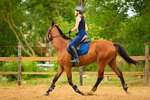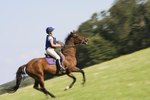Tips
Not all horses are born to rack. If you try the above steps persistently without any success, your horse may not be geared to be gaited this way.
The rack is a man-made gait. Horses are born walking, trotting and cantering or galloping pretty much on their own. However, there are many horses that take to the rack quite naturally. It is best to begin training a horse to rack at a young age, shortly after you break them to ride. But it is not out of the realm of possibility to train a seasoned horse to pick up this gait.
Begin with a visit from your farrier. You need to either pull the front shoes off of your horse, or simply leave very light plates on, and a heavier shoe on the back end. If you don't use a farrier, you can simply use a lightweight pair of training chains on your horse's back legs. The idea is to make him pull a bit more weight behind, to throw him a little bit off balance and encourage him to naturally flow into the rack.
Use a snaffle bridle to start. You can move to a double bridle (snaffle and curb bit) later on if desired once your horse has developed this gait.
Try to ease your horse into the rack from a walk. Do this by raising your hands toward your chest to raise her head. Don't worry if her nose is out too much. You can correct that later. Keep a very deep seat, legs and feet braced firmly in the stirrups, raise your hands and squeeze and cluck to move her forward. Work the bit in her mouth lightly to manipulate her movement. This should start slowly. Many horses slip right into a little rack, while some others take a bit more work. Do not force it. Be patient and work with her.
Remember the rack is a four-beat gait. Meaning when your horse is doing it correctly, he should only have one foot on the ground at a time. You will know this by the smoothness of the gait. His legs will be moving quickly, and it will be very easy to sit in the saddle without bouncing up and down. If you are bouncing from side to side too much, it means he is pacing. Basically two legs on the same side hitting the ground together. This is not a legitimate rack, and if you are showing the horse in competition, you will be penalized.
Move to the next level once your horse has learned to rack. Tuck her nose in while her head is raised up. When you feel she is comfortable with the gait, you can switch back to normal shoeing, and/or remove the chains from her hind end. The rack is a smooth, and sometimes very fast gait. So begin to push her forward and see how much speed she can endure. Remember to always keep a deep seat, and use the bridle to keep her balanced.
Tips
- Not all horses are born to rack. If you try the above steps persistently without any success, your horse may not be geared to be gaited this way.
Photo Credits
-
www.gaitedhorses.net




